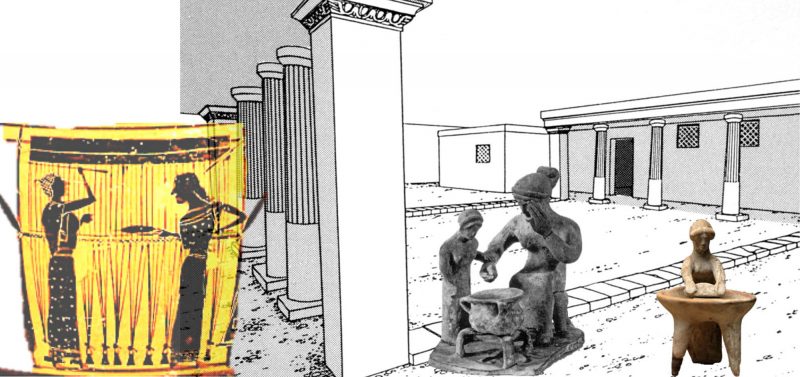
life in the Late Hellenistic villa as reflected by some of the objects used there.
* essays in the form of imagined narratives carry a light yellow background
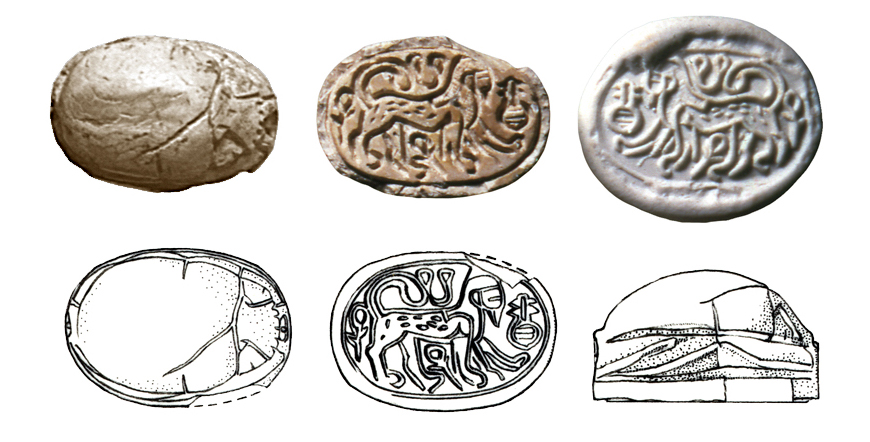
As I was overseeing construction of my villa-in-progress, I spotted a small object in the dirt.[1] Brushing it off, I made out a carved beetle, the size of a small stone, with designs carved on the bottom: a lion and some strange picture writing. I remembered hearing about such writing from Egypt.
“What brought you here?” I asked the object, “so far from home?” I slipped it inside my satchel. There are more important matters at hand. This villa is not going to build itself.
“Hey!” I heard in the distance, “what brought you here?” Here came a friend, checking up on his new home nearby.
“Just making sure all is in order. How goes it?”
“I journey tomorrow to Hippos. Perhaps you will join me?”
“Indeed! Although it will take us an entire day of walking, it will be worth it to shop in the great market there.”
By sundown the following day we were overlooking Lake Ginnosar, mingling with people and merchants. In one stall were trinkets, some with picture writing! I brought out my strange beetle for the merchant. Being a businessman, he first asked for coins in exchange for his expertise. I sighed, and obliged. This object is not going to read itself …
Turning it over, he surprised me: “This is quite ancient – yet I have seen many like it. The creature with a lion’s body and crown is an Egyptian sphinx. He strides towards the sign of nefer, for good luck, happiness, and beauty. You know, such objects can be made into rings. Shall I craft one for you?”
I declined; I had paid – and learned – enough. I left to meet my friend at the wine merchant, and showed off my small find.
“What will you do with it?”
“It was luck that led me to it; its powers must be true. I will make sure to build it inside a wall of my new villa so that it may lead all who live there to happiness.”
[1] Larson, TA 2.3, pp. 93-94.
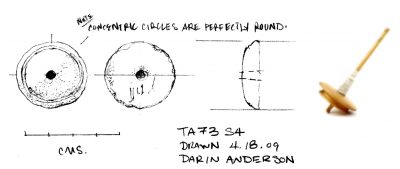
WT 35 is a spindle whorl found in a Hellenistic 2A stratum. It is made out of steatite, a stone that is not local to the area; thus the whorl (or the stone) must have been imported. It weighs 10 grams and is slightly smaller than a fifty-cent piece in diameter. On the convex face are two concentric circles incised around the circumference.
A whorl’s function is to provide circular momentum to the spindle’s long stick as it spins, drawing out thread from raw material and winding it around the spindle. Precise care must be taken in manufacture, as the centripetal force that allows the whorl to spin quickly and evenly is hindered if the hole is off-center, or if the whorl is heavier on one side. The spindle whorls used by modern weaving enthusiasts are virtually identical to WT 35 due to the essential simplicity of their function: to spin.
Spinning thread could have been performed year-round at Tel Anafa, whether to provide thread for the site’s residents to use for their own clothing or to weave textiles for trading. A weaver likely kept a ‘kit’ of multiple whorls of different sizes and weights: a heavier whorl is best for heavier, thicker material while a lighter whorl suits fine, delicate thread. From the 44 whorls from Tel Anafa that were weighed, it is clear that whorls whose dimensions and weight cluster around those of WT 35 were favored. This size would have been used to spin short staple wool and fine thread, appropriate for sewing and also for weaving lighter garments, whose prevalence may have been dictated by the climate or personal preference.[1]
[1] Katherine A. Larson and Katherine M. Erdman, “Tools for Textile Manufacture,” in TA II, iii, esp. pp. 157-158, 159-161, and 163-164.

I enter the small, dark room far from the master’s quarters; far enough so that no one will hear me. My figurine fits perfectly into the palm of my hand. I made it quickly the day before while in a rage, fully aware my skill is nowhere as great as the skilled clay sculptors. I run my finger over its owl like, unpleasant face and flat body. I smile at his tied hands, which I molded using a sharp knife that I almost cut myself with. I wish I could have afforded to make him in lead, but the clay was cheaper and I believe it can still get the work done. Recently I’d encountered a merchant who told me that in Egypt they use clay and wax figurines to channel evil forces – exactly what I need for the owner of this villa who has sold my wife and child, sending them across the sea to an unknown place. Now, just as I was told, I throw the figurine into the hot oven, and carefully quietly whisper my curse. I just hope it works.
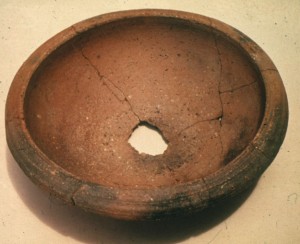
This humble, well-used grinding bowl is one of at least 240 mortaria from Tel Anafa’s late Hellenistic period.[1] Seen alongside the site’s other utility and storage vessels—kraters, large jugs, storage jars, small containers, and funnels—we may conclude not only that food processing and preparation were an extremely important part of daily life at Tel Anafa, but also that residents were growing and processing much of their own food on-site. In other words, the villa’s inhabitants were largely self-sufficient in terms of food, and not dependent upon imported foodstuffs. This becomes clearer when the Late Hellenistic assemblage of kitchen ware is compared to that of the later, Early Roman period of settlement, which had many fewer mortaria but a great number of large jars, probably for foodstuffs, brought in from elsewhere. Residents of the later settlement were likely importing much of their food, and so had less need for preparation vessels such as this.[2]
[1] Berlin in TA II, i, p. 22.
[2] Berlin in TA II, i, pp. 22, 31; Andrea M. Berlin, “What’s for Dinner,” Biblical Archaeology Review 25, no. 6 (1999): 45–56.
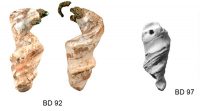
The second of these objects (BD 97) is what remains of an auger shell. A hole has been drilled near the top to transform it into a bead. Beads have been a form of personal adornment since the beginning of humanity. Teeth, bone, and shell were the first materials that were transformed in this way. Beads and pendants were found in almost every trench that was excavated at Tel Anafa, speaking to their widespread use, but shells consist of only a small portion of the bead finds. This could point to shell beads being significant. The first of these objects (BD 92) is one of several replicas of auger shell beads made out of glass (traditionally considered a luxury material) that point to the high status assigned to shell beads. Body adornment signifies beauty and fashion preferences, social standing, and economic status. Both of these beads traveled more than 30 km over a mountain range to arrive at Tel Anafa. Their presence would have evoked travel, important connections, and associations with the sea. Any one of these connotations could have been significant in the social and religious lives of the people who wore these beads.[1]
[1] Larson in TA II, iii, pp. 117-118.
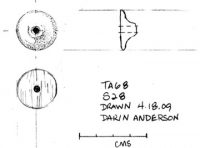
This stone whorl was recovered from a room on the mound’s south slope. The excavation spot is locus 3212, meaning the twelfth locus identified in trench 3.2.[1] The room’s walls were made of rough basalt stones, which were much disturbed in later eras when stone was robbed out for use elsewhere. This activity means that the date of the locus, and therefore the objects found in it, cannot be determined with certainty. Yet this small object, in tandem with other finds in this same area— a bone weaving-tool (WT 349),[2] a grinding bowl, ceramic cooking vessels, and a tanur (oven)—bespeak a common date and character. All are late Hellenistic, and taken together suggest a room for domestic chores, perhaps carried out on behalf of the villa’s wealthier residents.[3] Thus this single object from a disturbed context still makes its contribution to reconstructing life at the site.
[1] Herbert in TA I, i, p. 103.
[2] Larson and Erdman in TA II, ii pp. 193, 197.
[3] Herbert in TA I, i, p. 100.
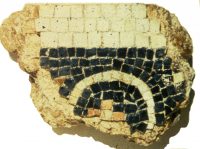
I was born into an artisan family, within a guild of mosaicists. The guild provided us craftsmen with an organization and worked to fortify the tradition by teaching apprentices and bestowing honors. I was an apprentice from birth until my teenage years, always learning how to master my craft. As a young boy, I mostly helped keep items arranged in the studio, and always carefully observed my elders. I was most inspired by the way my father worked, arranging the small pieces as one would paint a fresco. I dreamed one day of creating my own images, with mortar, stone, and grout. When I came of age, I became a member of the guild alongside my father. Our craft spans the Mediterranean, creating a web of shared knowledge. Members were sometimes called upon to work in distant places – and one day, that opportunity arrived for me. The boat sailed as far to the East as the sea would allow, to the city of Tyre. From there, I travelled inland to a remote villa, the home of rich man with sophisticated tastes, and here undertook my first independent assignment.
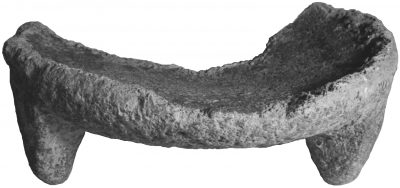
A young servant woman walks across a courtyard. She retrieves her favorite grinding bowl, and makes her way to join a small group of other men and women working grain. This is the best of my chores, she thinks to herself as she settles down and encircles the bowl with her legs. With its short feet and small diameter, it is the perfect size: she only needs to straighten her arms to reach its edges. The porous stone is almost rough against her hands as she pounds the grain with her handstone, crushing its hard exterior into powdery remains that catch momentarily in the bubbly interstices. She chats with others nearby who are adding water to prepare the dehusked grain for baking. Some days, when she is feeling boisterous, she likes the camaraderie of bread making, talking freely with others while they work. Other days she’d rather sit quietly, humming to herself in concentration, adding her strength to that of the stone. Every day, she likes the sound and the feel of this bowl, elemental and useful.
